
16 minute read
Everyday Korean
Episode 35
음식 배달 (Food Delivery)
Advertisement
By Harsh Kumar Mishra
Grammar
~ 지요: This sentence ending is used with verbs, adjectives, and in some cases with nouns to make expressions like question tags in English, or to ask for confirmation on something said. Ex: 내일 회사에 가지요? . You’ll go to the office tomorrow, won’t you?
~ 때문에: This is used after noun to express that something is the reason behind something. Ex: : 시험 때문에 많이 바빠요. I’m very busy because of my exam.
Vocabulary

배달시키다 낫다 앱 쓰다 주문하다 맛있다 추천하다 할인쿠픈 order (have it delivered) be better mobile app use (v.) order (v.) tasty recommend discount coupon
Food Delivery-Related Vocabulary
메뉴판 맛집 포장 방문 1인분 한식 분식 야식 주문내역

menu restaurant self-pickup/takeout serving for one person Korean food snacks/noodles late night food order history 앤드류: 누나, 뭐 드실래요? [Nuna, mwo deu-shil-lae-yo?] Andrew: Nuna (=Jeongmin), what will you have?

정민: 배달시켜요? 식당에 안 가요? [Bae-dal-shi-kyeo-yo? Shik-ttang-e an ga-yo?] Jeongmin: Are you ordering? Are we not going to the restaurant?
앤드류: 코로나 때문에 식당으로 가는 것보다 시켜 먹는 게 낫지요. [Corona ttae-mun-e shik-ttang-eu-ro ga-neun geot-bo-da shi-kyeo meong-neun ge nat-ji-yo.] Andrew: Due to COVID-19, won’t it be better to order out and eat in than go to a restaurant?
정민: 그 말이 맞네. 앤드류는 무슨 앱을 써? [Geu ma-ri man-ne. Andrew-neun mu-seun app-eul sseo?] Jeongmin: That’s a good thought. What app do you use (for ordering)?
앤드류: ‘배달의민족’도 쓰고 ‘요기요’도 써요. [Bae-dare-min-jok-tto sseu-go yo-gi-yo-do sseo-yo.] Andrew: I use both Baemin (short for “Baedare-minjok”) and Yogiyo.
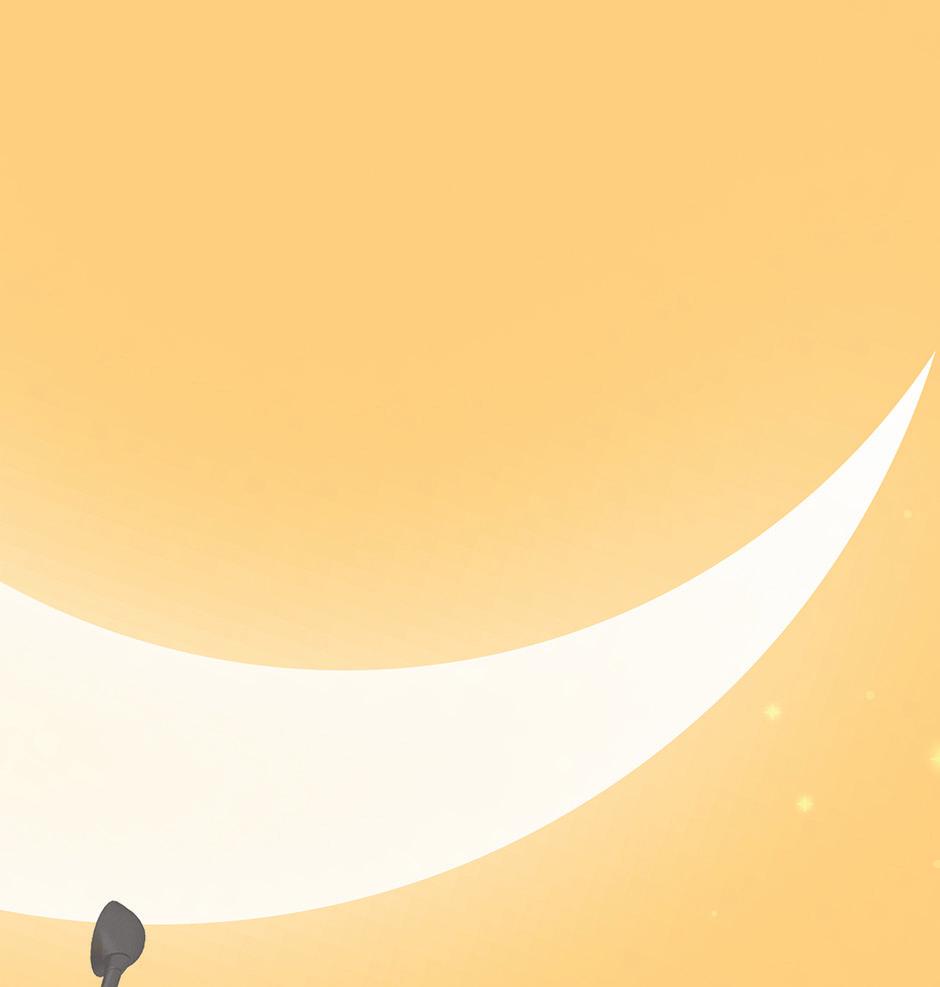
정민: ‘요기요’에서 주문하자. 나 거기 맛있는 식당을 추천해 줄게. [Yo-gi-yo-e-seo ju-mun-ha-ja. Na geo-gi ma-shin- neun shik-ttang-eul chu-cheon-hae jul-kke.] Jeongmin: Let’s order from Yogiyo. I will recommend a nice restaurant there.
앤드류: 좋아요. 저 ‘요기요’ 할인쿠픈도 있어요. [Jo-a-yo. J eo yo-gi-yo ha-rin-ku-peun-do it-seo-yo.] Andrew: Awesome. I also have a Yogiyo discount coupon.
정민: 잘됐네. [Jal-dwaen-ne.] Jeongmin: That’s great.

TOPIK GUIDE (topikguide.com) is the most comprehensive website devoted to the TOPIK exam. It has been helping Korean language learners pass the TOPIK (Test of Profi ciency in Korean) for more than eight years. On our website, you can get all the TOPIK updates, grammar and vocabulary material, and study tips. You can also visit our TOPIK Guide YouTube channel.
Belgrade Fortress and Kalemegdan Park
In the Heart of the City That Never Sleeps
Written and photographed by Jana Milosavljevic
Voted as Europe’s top travel destination in 2019 according to Travel Lemming, a website dedicated to promoting the world’s emerging travel destinations, Serbia and its tourist site gems have continued to appeal to growing numbers of tourists from around the world ever since. Serbia is located in the heart of the Balkan Peninsula in southeastern Europe and shares its border with eight countries. Serbia has a unique location that occupies the crossroads that connect Western and Oriental Europe. At times, this location has been rather troublesome, such as how the Serbian territory has been the battleground of many armies throughout history. Due to this fact, what Serbia nowadays has to off er to its visitors is a fusion of the traditional and modern, as well as the clash of a long and turbulent history with newly developed urban districts and a vibrant nightlife. Th e best representative of this contrast is none other than the country’s capital – Belgrade.
Belgrade is one of the oldest cities in Europe. It is believed that it was fi rst settled between twenty-thousand to fi ft ythousand years ago by Th raco-Dacians, followed by Celts, Romans, and Slavs. Th anks to its strategic location at the confl uence of the Danube (Europe’s second-longest river) and the Sava River, Belgrade has been fought over in as many as 115 wars, resulting in its destruction and subsequent rebuilding 44 times. Furthermore, it has had its name changed 15 times throughout history. Th e Celts called it “Sngidun” and the Romans “Singidunum,” while the fi rst mention of its current name, “Belgrade,” was in the ninth century. Its name in the Serbian language is “Beograd,” which is a compound of the words beo meaning “white,” and grad meaning “city,” making Belgrade’s best translation the “White City.”

Belgrade Fortress and Kalemegdan Park are located on the grounds that are considered to be Belgrade’s birthplace. Belgrade Fortress, continually destroyed and rebuilt in the period between the second and eighteenth centuries,
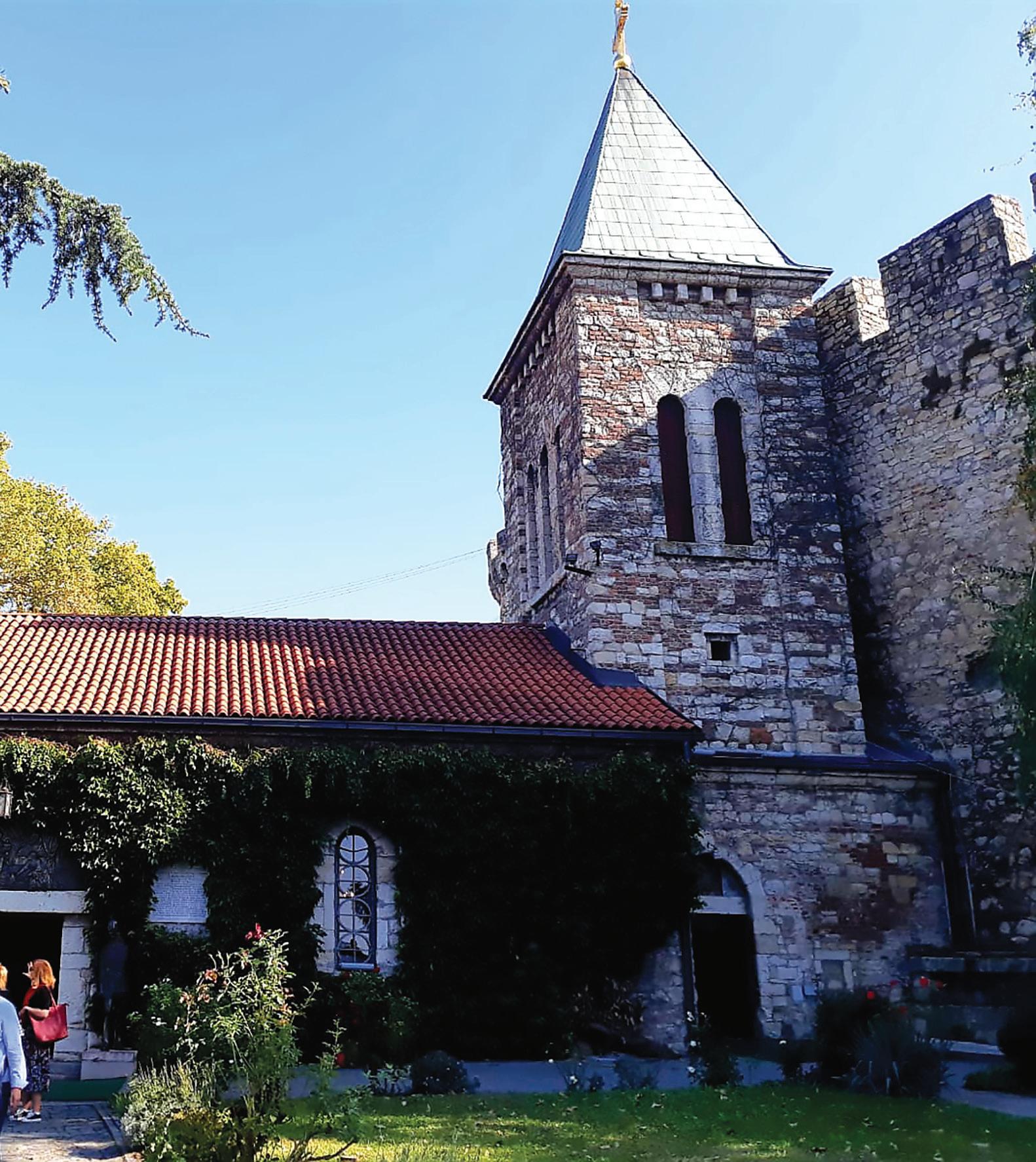
still stands strong as a heritage site of monuments left by Romans, Ottomans, Austro-Hungarians, and many more armies, peoples, and conquerors. Due to its perseverance through history despite so many conquests, the fortress has become a symbol of the vitality of the Serbian people and of the city of Belgrade itself, which continues to grow day by day.
Ruzica Church
Belgrade Fortress
Belgrade Fortress is made up of an upper and lower town. If you follow the walls of the fortress, you will be able to see as many as 20 town gates from different periods of history. Among many interesting sights inside its walls is the so-called “Roman Well,” which is neither Roman nor a water well and was actually built in the 18th century.
In addition to this, an authentic 18th-century Austrian clock tower exists as a rare monument that has preserved its original architectural and stylistic features, without having undergone any repairs or modifications to this day. Located inside the fortress walls is also an Ottoman mausoleum – Damad Ali Pasha’s Turbeh – a very rare, preserved monument of Islamic architecture in Belgrade. Another interesting preservation found here is what is known as Hamam – the Old Turkish Bath.
Those who are interested in military history should not miss the opportunity to visit the Military Museum, surrounded by authentic old tanks and artillery, as well as the Nebojsa Tower – the medieval canon tower that the Ottomans transformed into a dungeon. A special treat for military enthusiasts that can be found near the tower is the Big Gunpowder Magazine, set up by the Austrians at the beginning of the 18th century as a safe place to hide artillery, while today it serves as a museum that houses a collection of stone monuments that include Roman sarcophagi, tombstones, and altars.
Among the many foreign memorials in the fortress, one must not forget the representative Serbian ones: the Victor Monument and Ruzica Church. The Victor Monument (or Pobednik in Serbian) is a 14-meter-high bronze sculpture of a strong, nude warrior holding a sword in his right hand and a pigeon in his left hand, created by the sculptor Ivan Mestrovic. Despite being at first disliked by its own citizens (similar to how the Parisians disliked the Eiffel Tower), the Victor Monument finally came to be one of the most prominent symbols of Belgrade and victory itself over time. It stands proud on the upper town’s plateau overlooking the confluence of the two major rivers in the region. Ruzica Church (ruzica meaning “small rose” in Serbian) was dedicated to the birth of the Mother of God. It served primarily as an Austrian gunpowder magazine, but after the Serbs regained the fortress, they restored the church, adding a bell tower and turning it into an Orthodox Christian church. At the entrance of the church are two bronze figures, one of a medieval knight and the other of a soldier from the First World War, both of which are thought to guard the church.
Kalemegdan Park
The vast field in front of Belgrade Fortress, now converted into Belgrade’s biggest and most beautiful park, was named Kalemegdan by the Ottomans, by joining the Turkish words kale, which means “city” or “fortress,” and megdan, meaning “battlefield.” In the park, one can follow
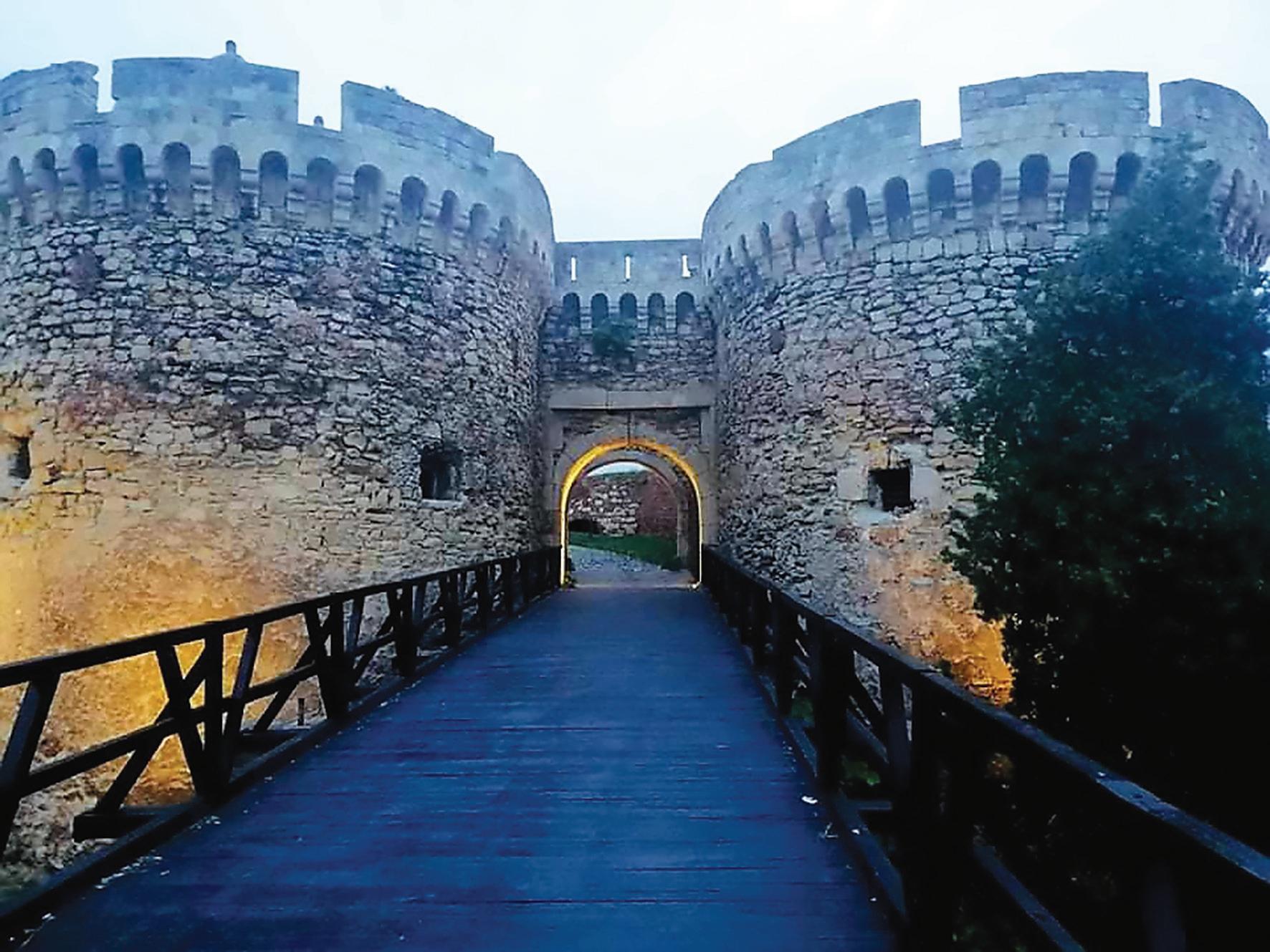
winding walking paths and discover shady benches, picturesque fountains, random statues, and incredible river views while watching beautiful river sunsets. Hidden in the park are also more modern monuments, such as the Monument of Gratitude to France unveiled in 1930, as well as more exotic monuments, like a Japanese fountain that was erected in 2010 in gratitude to the people of Japan for donations that the City of Belgrade received.
Locals love Kalemegdan Park, so you will never fi nd the park empty. In the morning, you can meet people going for a morning jog or dog lovers with their pets. During the day, you will almost defi nitely see grandpas playing chess and bickering, as well as youngsters having picnics during breaks from their studies, while nights are reserved for romantic walks and dates. Also, if you are in search of authentic souvenirs, you will surely fi nd them here. Many people take out to sell even their actual possessions from the past that cannot easily be obtained nowadays – things such as old paper money, old coins, badges, traditional hats, shoes, and instruments.
Nightlife Next to History
Lonely Planet, a website that publishes popular travel guides, referred to Belgrade as “the City with the Best Nightlife in the World,” and anyone who has ever visited might confi rm the statement. Moreover, further demonstrating that Belgrade’s attractions are truly a fusion of the past and present is the fact that right below Belgrade Fortress’ walls, under a high cliff , are the city’s most famous clubs – splavs. Splavs are fl oating river clubs that have come to symbolize Belgrade’s irresistible nightlife. Th ere are around 170 of them all along the banks of the two rivers, so no matter what kind of music you like to listen to, you will defi nitely fi nd a river club that suits your taste. Th ese fl oating clubs have become synonymous with great parties and never-ending fun.
If you are not interested in partying on the river, then you can actually go clubbing inside the Fortress. Barutana is an open-air club borrowing its space from a unique 17th-century warehouse, the original purpose of which was to store gunpowder that was used to defend the fortress throughout history. Finally, for those interested in experiencing the more traditional way in which Serbs have fun, just a 20-minute walk from the fortress is Skadarlija Street, the “bohemian street,” another place where music and singing can be heard until dawn. Skadarlija Street is home to the famous kafanas, or traditional Serbian taverns, where you can eat and drink Serbian traditional delicacies and enjoy your time while singing and dancing to the sounds of traditional music with the locals.
▲ Kalemegdan Park

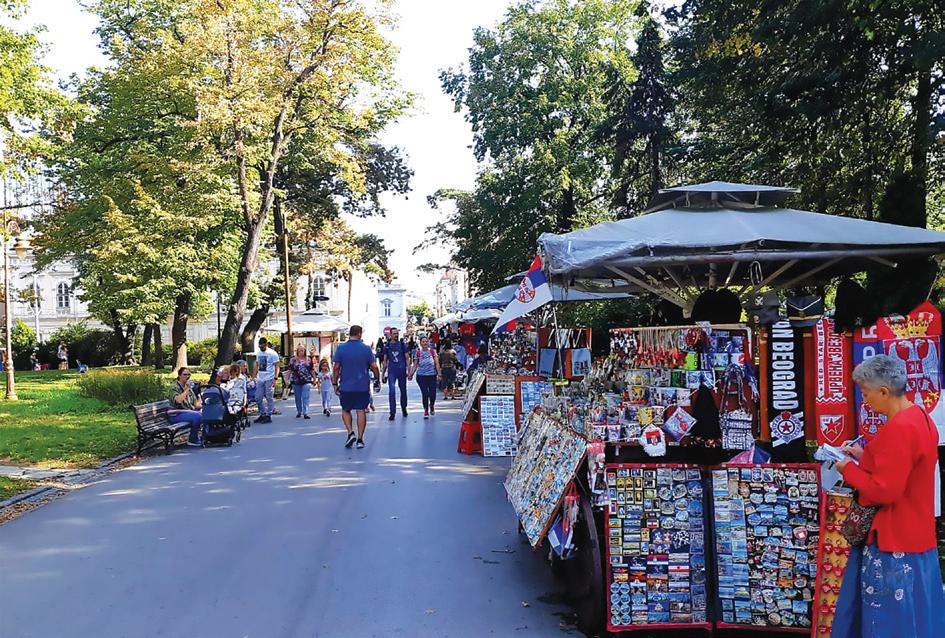
▲ Various unique souvenirs.
▲ Th e confl uence of the Danube and the Sava River.

The Author
Jana Milosavljevic was born and raised in Serbia. She currently lives in Gwangju, and she loves exploring and learning about new cultures and meeting new people. In order to be able to communicate with as many people as possible, apart from Serbian, she has learned English, Japanese, Korean, and German. Instagram: @janemiya
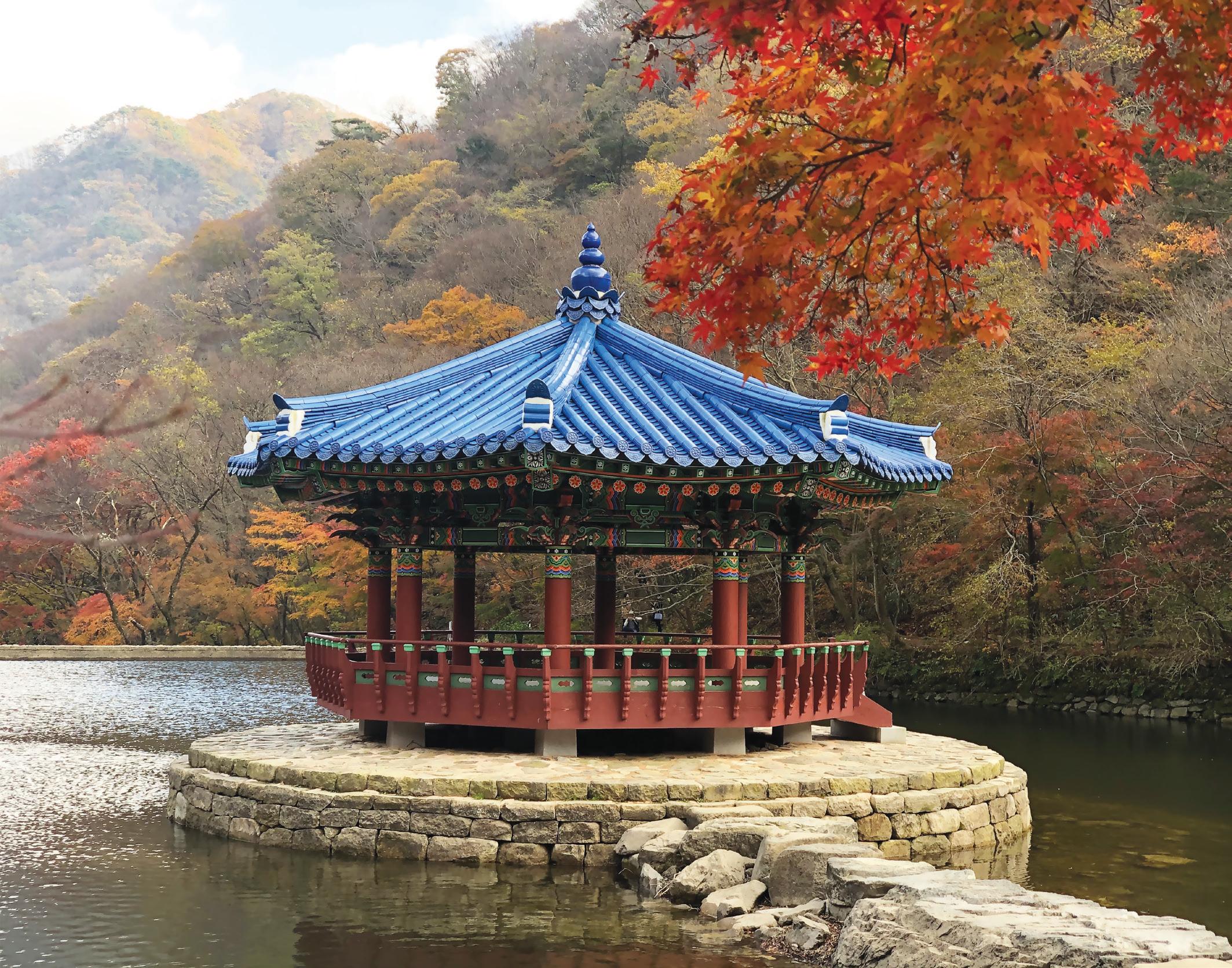
Autumn Hues of Naejang-san

Aft er reading an article of the top fi ve spots in Korea to visit for fall foliage and realizing that I lived very close to one of them – Naejang-san (내장산), a mountain with a temple in Jeong-eup (정읍) – I booked myself a train ticket to witness the 500-year-old beauty myself.
I decided to go on a Monday, thinking everyone would then be at work or school, so I could avoid the crowds. Despite the gray sky, I had high hopes as I boarded an empty early-morning train at Gwangju Station. As per my expectations of a rural area, there was only one hourly bus from the station to Naejang-san.
Having arrived at what looked like a major meeting point for hikers – I realized how naïve I was. Perhaps the Koreans were all at the offi ce, but there were guides everywhere waving the Th ai and Hong Kong fl ags and calling out to their groups. I heard multiple languages being spoken. Overwhelmed by the crowd, I decided to follow the signs to the national park instead. True to autumn nature, the dull sky only added to the vibe. Trees were at diff erent stages of yellows, oranges, and browns. Long walks along winding roads and a short shuttle bus took me closer to the beautiful temple, Naejang-sa (내장사). Th e area was well accustomed to tourists, as there were busking concerts, street vendors, and a rich festival vibe as I walked around. Riding the cable car, I could see the gradation of colors as I soared above the trees. Views from the pagoda, a rocky climb back down to the temple, and then the pièce de résistance – the featured blue-roofed pavilion in the center of the lake. Even the travel articles didn’t manage a picture of this pavilion without tourists in it, but I did! I took my shot, savored the moment, and decided that was the best part of this day – which had been a constant feast of nature. Th ey say a picture says more than a thousand words, but that day, a picture did not do justice to what I saw with my own eyes. If you live in Korea, I urge you to experience the myriad of autumn shades at Naejang-san.


The Photographer
Originally from Belgium, Aline Verduyn has lived abroad for 20 years and is currently earning a master’s in Korean language education at Chonnam National University. In Korea, she has previously lived in Busan, Suwon, and Daegu, and has just crossed the one-year mark in Gwangju. She is very happy living here. Instagram: @gwangjumiin

▲ Broadway in Nashville.

Written and photographed by Lee Woo-seob
“Sweet Home Alabama,” the most beloved song among all the people of Alabama, does always please my ears. I recently worked at POSCO-AAPC (POSCO America Alabama Processing Center) for nine months as an intern. Not only did I learn job skills, but I also met amazing people during the internship. This might be the only article that you will read about Alabama – it’s neither New York nor Los Angeles!
What POSCO-AAPC does is basically slit huge steel coils into small pieces and ship them to local manufacturers such as Hyundai Heavy Industry, ABB, SPX, and Daimler. I had two main jobs while I was there. One was inspecting all the coils in the factory and putting them in the correct shipping orders. The other was dealing with customers regarding the quality of the products.
More than 90 percent of the workers at the workplace were local Americans. I met them for the first time at a weekly safety meeting. To be honest, I was afraid of the fact that so many different-looking people were expecting me to introduce myself to them. But soon, I was able to break down the cultural barrier due to their kindness and sincere consideration.
While there, I also used to train in Brazilian jiu-jitsu (BJJ) after work at Gracie Barra Pelham. I was so happy that I could find such an amazing place. All the people at the BJJ club treated me just like family. My eternal BJJ rival was Austin. The two of us trained extremely hard and made it to the final fight in many competitions. I recommend joining any type of club that you are interested in. It will enrich your life abroad with many friends and achievements for sure.
One fact about my experience in McCalla, Alabama, that may surprise you is that there was no public transportation, not even pedestrian walks! You ought to have a car just to go get groceries at Walmart. Indeed, you will need someone who can drive you home from a pub as
▲ Lee Woo-seob on the winner’s podium at a BJJ competition.

well. I got a white 2009 Honda Civic at a secondhand car dealer and it worked great. Th us, consider buying a car as soon as you move to Alabama.
You can easily fi nd some of the American South’s best tourist cities close to Alabama. Atlanta, Nashville, and New Orleans – all well known as Southern American tourist cities – are 3–5 hours away by car in diff erent directions. I got the chance to visit all three of these amazing cities. If you love music, I recommend you go to Nashville. Once you go to Broadway, you will see countless pubs fi lled with live music! You do not even have to pay for the live music over there. You can sit or dance on the dancefl oor with or without a drink.
Y’all wanna meet some cool American folks from the South? Th en Alabama is the best place for you to be!
The Author
Lee Woo-seob is a mechanical engineer who worked at POSCO-AAPC in Alabama, USA, on an internship.
Support the GIC! Be a Member!
Th e Gwangju International Center (GIC) is a nonprofi t organization established in 1999 to promote cultural understanding and to build a better community among Koreans and international residents. By being a member, you can help support our mission and make things happen! Join us today and receive exciting benefi ts! • One-year free subscription and delivery of the
Gwangju News magazine. • Free use of the GIC library. • Free interpretation and counseling services from the GIC. • Discounts on programs and events held by the
GIC. • Up-to-date information on GIC events through our email newsletter.
Annual Membership Fee
General: 40,000 won; Student: 20,000 won; Group: 20,000 won (min. 10 persons). Inquiry: member@gic.or.kr / 062-226-2733
Th e Gwangju News has been serving the community since 2001 by delivering news and information to the international communities of Gwangju. Send the Gwangju News to your family and friends back home, and let them know about Gwangju!
Annual Subcription Rates
• Asia and Australia: 40,000 won (US $40) • Europe: 50,000 won (US $50) • America, Africa: 60,000 won (US $60)
Payment can be made through bank transfer, cash, or Paypal.
Bank Transfer: Kwangju Bank (사)광주국제교류센터: 134-107-000999 Paypal: gic@gic.or.kr Inquiry: gwangjunews@gic.or.kr or 062-226-2733










